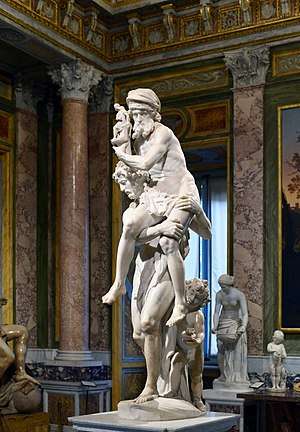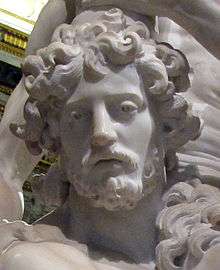Aeneas, Anchises, and Ascanius
| Aeneas, Anchises, and Ascanius | |
|---|---|
 | |
| Artist | Gian Lorenzo Bernini |
| Year | 1618–19 |
| Catalogue | 8 |
| Type | Sculpture |
| Medium | Marble |
| Dimensions | 220 cm (87 in) |
| Location | Galleria Borghese, Rome |
| Coordinates: 41°54′50.4″N 12°29′31.2″E / 41.914000°N 12.492000°E | |

Aeneas, Anchises, and Ascanius is a sculpture by the Italian artist Gian Lorenzo Bernini created c. 1618-19. Housed in the Galleria Borghese in Rome, the sculpture depicts a scene from the Aeneid, where the hero Aeneas leads his family from burning Troy.[1]
The statue was made by the sculptor Gianlorenzo Bernini (and it is often thought that he had help from his father, Pietro Bernini [2]) when he was twenty years old. Through his father Pietro, Giancarlo Bernini was becoming renown in the higher circles of Rome. Pietros’ famous Mannerist sculptures were even commissioned by the Pope (see figure 2c). Through some minor commissions for Pope Paul V, he was being able to get recognized as a very promising sculptor. The Pope couldn’t believe that a young boy could actually sculpt this kind of art works. Those sculptures, especially the antique ones caught eventually Scipione Borghese’s attention. Cardinal Scipione Borghese was next to the Pope, the most powerful man in Rome.
Scipione loved also arts, money and male physical beauty. [6] It is also thought that the sculpture is influenced by earlier works of other artists. The figure of Christ (Santa Maria sopra Minerva), made by Michelangelo, has served as example for the figure of Aeneas. Also, the head of Aeneas corresponds with Pietro Bernini's John the Baptist (Cappella Barberini in Sant’A ndrea della Valle). It is generally thought, that it has also elements derived from Raphaels Fire at the Borgo (Vatican Museum, Stanze di Borgo) and Barocci’s own interpretation of the Flight of Aeneas (Villa Borghese)[2]. Also, the stance of the Bernini sculpture looks a lot like a work that his father created, the Saint Matthew with Angel. Aeneas left foot and Ascanius right foot are standing forward, whereas in Pietros sculpture of Saint Matthew the stance is the same, but mirrored[2].
The life-sized group shows three generations of the Aeneas family. The young man holding an older man on his shoulder is Aeneas (see figure 3a). He gazes down to the side with a strong determination. Aeneas lineage from the gods, his mother is Aphrodite, is emphasized through the lion skin draped around his body. A lion skin stands commonly for power and is often related to Hercules, a descendant from Zeus[2].
Patronage
This was the Bernini's first commission from Cardinal Scipione Borghese. It probably started around 1618 and finished the succeeding year. It was one of a number of sculptures that would end up in the Villa Borghese, now the Galleria Borghese.[2]
Story
Bernini's inspiration for the work was the Aeneid, the Latin epic poem which tells the story of Aeneas, a Trojan who left his home city and eventually ended up in Italy, where he became a progenitor of the Roman people. The precise scene depicted is the moment when Aeneas carries his father, the elderly Anchises, and his son Ascancius from Troy, after it has been sacked by the Greek army.[3] In his hand, Anchises carries a vessel with his ancestors' ashes, on the top of which are two tiny statues of Di Penates, Roman household gods.[4]
Artistic Influences
Bernini has only just passed twenty when the work was completed. Therefore, it is not unusual to see that the style of execution still owed much to other artists - his own style would become more apparent with the other pieces commissioned by Cardinal Scipione Borghese. The influence of his father Pietro Bernini was evident in the rather lumpy handling of the figures. Elements of the sixteenth-century sculptor Giambologna occur, particular in how Bernini attempted to construct a sense of movement upwards from the boy Ascansius to his grandfather Anchises. The figure of Aeneas may be modelled on Michelangelo's sculpture of Risen Christ.[3]
Two painted influences are also cited. Firstly, the painting by Federico Barocci of the same topic, which was also in Cardinal Borghese's collection. But the more famous influence is from Raphael's fresco in the Vatican, Fire in the Borgo, which depicts the identical scene, showing Aeneas carrying his father with his son beside them.[3]
Critical Reception
The sculpture was for a considerable time considered to be by Bernini's father Pietro. Even when later evidence revealed the statue was by Gian Lorenzo Bernini, critical reception of the sculpture was mixed - Hibbard recognised the artistry in the contrast between Aeneas' firm skin and the sagging skin of the older Anchises, but also noted the statue as "cramped and tentative". Others have seen in the sculpture, as with the other sculptures for Cardinal Borghese, the evolution from earlier Mannerist sculptures.[3] Ann Sutherland Harris contrasts Bernini's work with Giambologna's Rape of the Sabine Woman. Giambologna's pyramidical composition invited viewers to walk around it, seeing different character expressions and indeed the shape and texture of their bodies from different positions; Bernini's sculpture, on the other hand, allowed the viewer to see the expression of the three characters from a single viewpoint - with much less of the story being evident when looked at from different angles.[5]
References
| Wikimedia Commons has media related to Aeneas, Anchises, and Ascanius by Bernini. |
- Notes
- Bibliography
- Avery, Charles (1997). Bernini: Genius of the Baroque. London: Thames and Hudson. ISBN 9780500286333.
- Baldinucci, Filippo (2006) [1682]. The Life of Bernini. University Park: Pennsylvania State University Press. ISBN 9780271730769.
- Bernini, Domenico (2011) [1713]. The Life of Giano Lorenzo Bernini. University Park: Pennsylvania State University Press. ISBN 9780271037486.
- Hibbard, Howard (1990). Bernini. London: Penguin. ISBN 9780140135985.
- Mormando, Franco (2011). Bernini: His Life and His Rome. Chicago: University of Chicago Press. ISBN 9780226538525.
- Pinton, Daniel (2009). Bernini. Rome: ATS Italia Editrice.
- Wittkower, Rudolf (1955). Gian Lorenzo Bernini: The Sculptor of the Roman Baroque. London: Phaidon Press. ISBN 9780714837154.